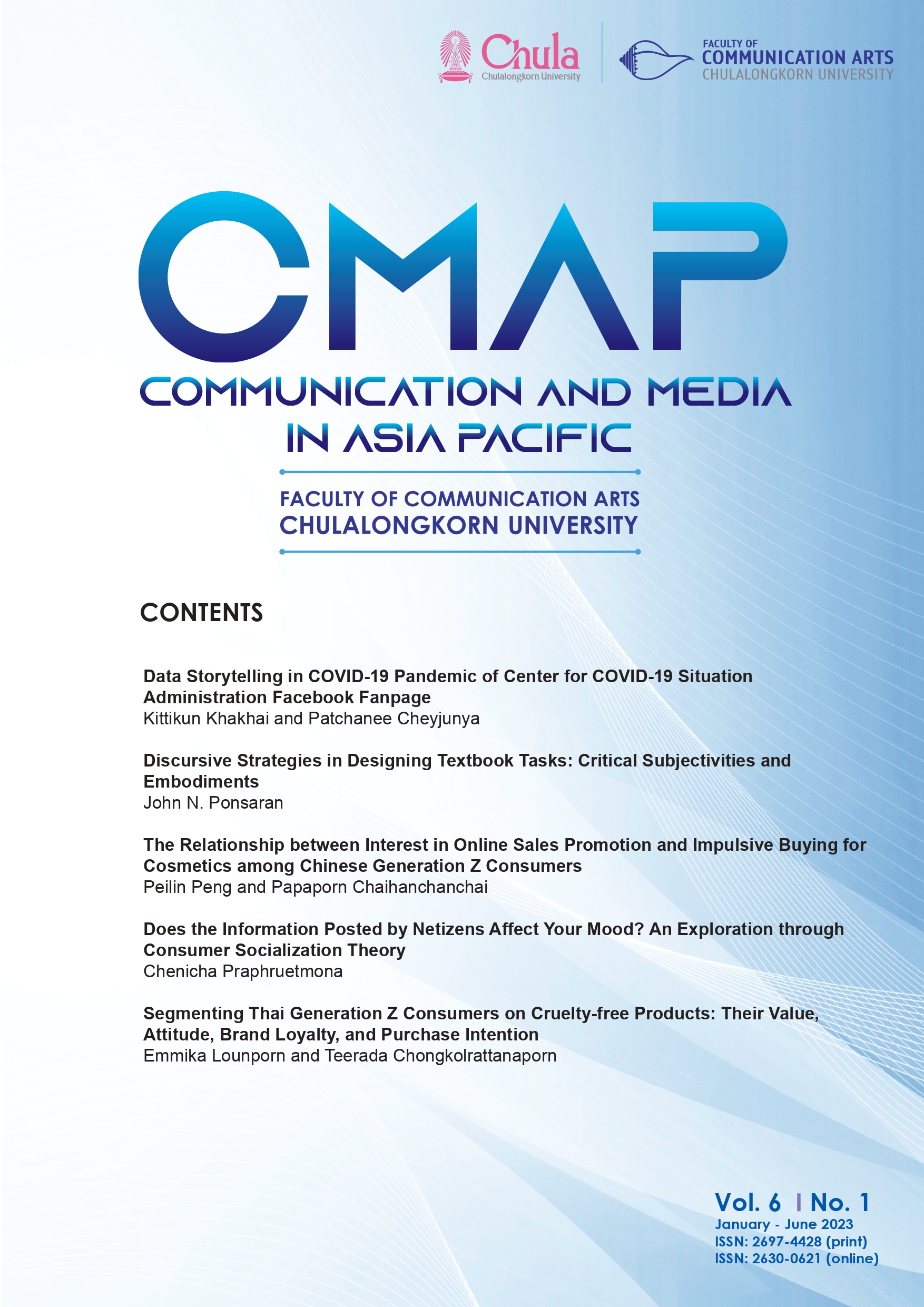Data Storytelling in COVID-19 Pandemic of Center for COVID-19 Situation Administration Facebook Fanpage
Main Article Content
Abstract
This study aimed to investigate data storytelling strategy in COVID-19 pandemic of Thailand’s COVID-19 Information Center and Center for COVID-19 Situation Administration (CCSA) by using content analysis from COVID-19 Information Center Facebook Fanpage from October 2020 to April 2021, and in-depth interview with administrator of Facebook Fanpage and communication officer of Center for COVID-19 Situation Administration. The results showed that: 1) the data storytelling of COVID-19 pandemic had been published in 725 posts with storytelling sequences, 2) the purpose of data storytelling is to provide COVID-19 information, urge the public to comply with government measures and build confidence in the implementation of government measures, 3) data storytelling content includes COVID-19 situation, government measures, and COVID-19 vaccines, 4) data storytelling type is author-driven stories and can be categorized based on data content criteria, including comparison combined with change over time, comparison, project forward, and change over time, 5) data storytelling arc is an entire data storytelling arc type, 6) Gestalt theory and 14 types of charts were applied to data visualization, and 7) data storytelling tool are Tableau, Adobe Illustrator and Microsoft Excel. Moreover, the suggestion for data storytelling type in COVID-19 pandemic is that it should include a mixed author-driven stories and reader-driven stories. Interactive media can be applied in this mixed storytelling. It will encourage audiences to participate and support to better understand of government measures.
Article Details
References
Biswas, M., & Sipes, C. (2020). DataViz and data storytelling education in journalism and communication programs. Teaching Journalism & Mass Communication, 10(2), 28-41.
Comba J. L. (2020). Data visualization for the understanding of COVID-19. Computing in Science & Engineering, 22(6), 81-86.
Dey, S. K., Rahman, M. M., Siddiqi, U. R., Howlader, A., & Tushar, A. (2021). Analyzing the Global impact of COVID-19 Vaccination progress: A result-oriented storytelling approach. medRxiv. https://doi.org/10.1101/2021.03.26.21254432
Dykes, B. (2020). Effective data storytelling: How to drive change with data, narrative and visuals. Hoboken, NJ: John Wiley & Sons.
Kleechaya, P. (2019 ). People's Accessibility of health information in international spreading of emergimg infection disease and their self-care. Journal of Communication Arts Review, 23(1), 29-44.
Knaflic, C. N. (2015). Storytelling with data: A data visualization guide for business professionals. Hobokenn, NJ: John Wiley & Sons.
Kosera, R. (2017). An argument structure for data stories. Paper presented at the Eurographics Conference on Visualization. https://diglib.eg.org/bitstream/handle/10.2312/eurovisshort20171129/031-035.pdf
Lee, B., Nathalie, H. R., Petra, I., & Sheelagh, C. (2015). More than telling a story: Transforming data into vissually shared stories. IEEE Computer Graphics and Applications, 35(5), 84-90.
Limsrigam, P., Saaithanakornkaew, S. & Apisupachoke, W. (2021). Information perception concerning novel CORONAVIRUS (COVID-19) through social media on the attitudes and preventive behaviors of citizens in Bangkok. Journal of MCU Nakhondhat 8(9), 18-33.
Liu, J. (2021). Visualization of data journalism of China’s mainstream media in public health emergences: Taking the data news section of Xinhua Net as an example. Paper presented at the 5th International Conference on Machine Vision and Information Technology. https://doi.org/10.1088/1742-6596/1880/1/012038
Maneehaet, S., & Chuathong. s. (2020). Health communication in COVID-19 situation of Department of Disease Control using infographic narratives. Journal of Mass Communication, 8(2), 91-119.
Ojo, A., & Heravi, B. (2018). Patterns in award winning data storytelling Digital Journalism, 6(6), 693-718.
Order of the Prime Minister No. 72/2020, (2020). Establishment of the COVID-19 Information Center.
Order of the Prime Minister No. 72/2020, (2020). Establishment of the Center for COVID-19 Situation Administration (CCSA).
Rungsit, K. (2020). Media used by government sector in the COVID-19 epicdemic prevention campaign in Thailand. Journal of Mass Communication Technology, RMUTP, 5(2), 77-86.
Sakamoto, Y., Sallam, S., Salo, S., Leboe-McGowan, J., & Irani, P. (2022). Persuasive data storytelling with a data video during Covid-19 infodemic: Affective pathway to influence the users' perception about contact tracing apps in less than 6 minutes. 2022 IEEE 15th Pacific Visualization Symposium, 176-180.
Segel, E., & Heer, J. (2010). Narrative visualization: Telling stories with data. IEEE transactions on visualization and computer graphics, 16(6), 1067-1073.
Sha. (2018). An analysis of SARS news reports in China Daily. Journal of Social Academic, 11(2), 218-222.
Sheridan, S. (2021). The basics of data storytelling. Laramie, WY: University of Wyoming.
Simone, F. D., Presta, R., & Protti, F. (2014). Evaluating data storytelling strategy: A case study on urban changes Paper presented at the The 6th International Conference on Advanced Cognitive Technologies and Applications.
Slaney, M. (2012). Tell me a Story. IEEE Computer 4-6.
Thai Graphic Designer Association (2022). The infographic problem of CCSA. Retrieved from https://www.sanook.com/news/8415410/
Vora, S. (2019). The power of data storytelling. New Delhi, India: Sage.
Weber, W. (2018). Data stories. Rethinking journalistics storytelling in the context of data journalism Studies in Commonication Sciences 18(1), 191-206.
World Health Organization. (2020). Managing the COVID-19 infodemic: Promoting healthy behaviours and mitigating the harm from misinformation and disinformation. Retrieved from https://www.who.int/news/item/
Zhao, Y., Blount, T., Koesten, L., & Simperl, E. (2019). Structured and uncertainty-aware data storytelling. Paper presented at the CHI ’19 Workshop on HCI for Accurate, Impartial and Transparent Journalism: Challenges and Solutions.

